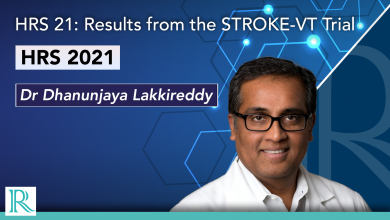Search results
Author(s):
Linda D Gillam
Added:
3 years ago
A patient presents to their physician with progressive dyspnea on exertion, orthopnea, and fatigue. Physical examination reveals bibasal rales, distended neck veins, an S3 gallop, and an apical holo-systolic murmur. The clinical diagnosis is straightforward - this patient has congestive heart failure.Almost certainly one of the first tests performed in this patientÔÇÖs diagnostic evaluation will…
View more
Author(s):
Sanjiv Kaul
Added:
3 years ago
Contrast echocardiography (CE) is 40 years old this year. Gamiak and Shah first described the use of ultrasound (US) contrast in 1968 during the early days of M-mode echocardiography.1 In that study, US contrast was produced by inadvertently introducing air bubbles in the indocyanine green solution that was injected into the left heart during cardiac catheterisation and observing its appearance…
View more
Author(s):
Stacey Neuman
,
Micheal P Howard
,
John D Day
Added:
3 years ago
Implantable cardioverter–defibrillators (ICDs) are being implanted in an ever-increasing number of patients at risk for sudden cardiac death. To ensure the efficacy of the defibrillation system, step-down defibrillation threshold (DFT) testing has traditionally been used to ensure that the ICD can appropriately detect and terminate clinical ventricular fibrillation (VF).
Currently, the most…
View more
Author(s):
Michael H Picard
Added:
3 years ago
Non-invasive imaging of the heart continues to evolve and improve. Cardiovascular ultrasound (echocardiography) continues to play an important role in the diagnosis and assessment of responses to therapy of many cardiac conditions. Even as the clinical applications of newer techniques such as cardiac computed tomography (CT) and cardiac magnetic resonance imaging (CMRI) increase, the role of…
View more
Author(s):
Dhanunjaya Lakkireddy
Added:
2 years ago
Dr Dhanunjaya Lakkireddy (Kansas City Heart Rhythm Institute, Overland Park, KS, US) sits down to discuss the findings of the STROKE-VT Trial, which investigated the use of aipaxaban in reducing blood clots and stroke risk after an ablation procedure.
Questions:
1. Please summarise the aim, study design and endpoints?
2. What were your major findings?
3. What further research is required?
4…
View more
Author(s):
Otto A Smiseth
,
Anders Opdahl
,
Espen Boe
,
et al
Added:
3 years ago
Abstract
Heart failure with preserved left ventricular ejection fraction (HF-PEF), sometimes named diastolic heart failure, is a common condition most frequently seen in the elderly and is associated with arterial hypertension and left ventricular (LV) hypertrophy. Symptoms are attributed to a stiff left ventricle with compensatory elevation of filling pressure and reduced ability to increase…
View more
Author(s):
G Hamilton Baker
,
Girish S Shirali
Added:
3 years ago
Congenital heart disease affects approximately 0.8% of the population.1 It is also estimated that there are approximately one million adults in the US living with some form of congenital heart disease.2 In daily practice, echocardiography is the most widely used imaging modality for diagnosis and evaluation of these patients. As medical technology has developed, this modality has continuously…
View more
Interventional Echocardiography
Author(s):
Roy Arjoon
,
Ashley Brogan
,
Lissa Sugeng
Added:
3 years ago
Article
Author(s):
Daniel A Goor
,
Samuel Sclarovsky
Added:
3 years ago
According to Myerburg and Costellanos, the introduction of cardiac revascularization to medicine (coronary artery bypass grafting [CABG]) almost 50 years ago led to a decline in the age-adjusted mortality from coronary artery disease (CAD),1 but brought no change to the fraction of coronary deaths that are sudden and unexpected.1 Of the 650,000 who die annually in the US of CAD, 300,000–350,000…
View more
Author(s):
Soraya M Samii
,
Javier E Banchs
Added:
3 years ago
Abstract
The concept of using an implantable device to manage arrhythmias and heart failure started over 50 years ago. Since then, we have seen these devices improve patient outcomes from bradyarrhythmias, atrial fibrillation, ventricular arrhythmias, and heart failure. These devices are now standard of care in the management of patients and include pacemakers, implantable cardioverter…
View more










 « First
« First